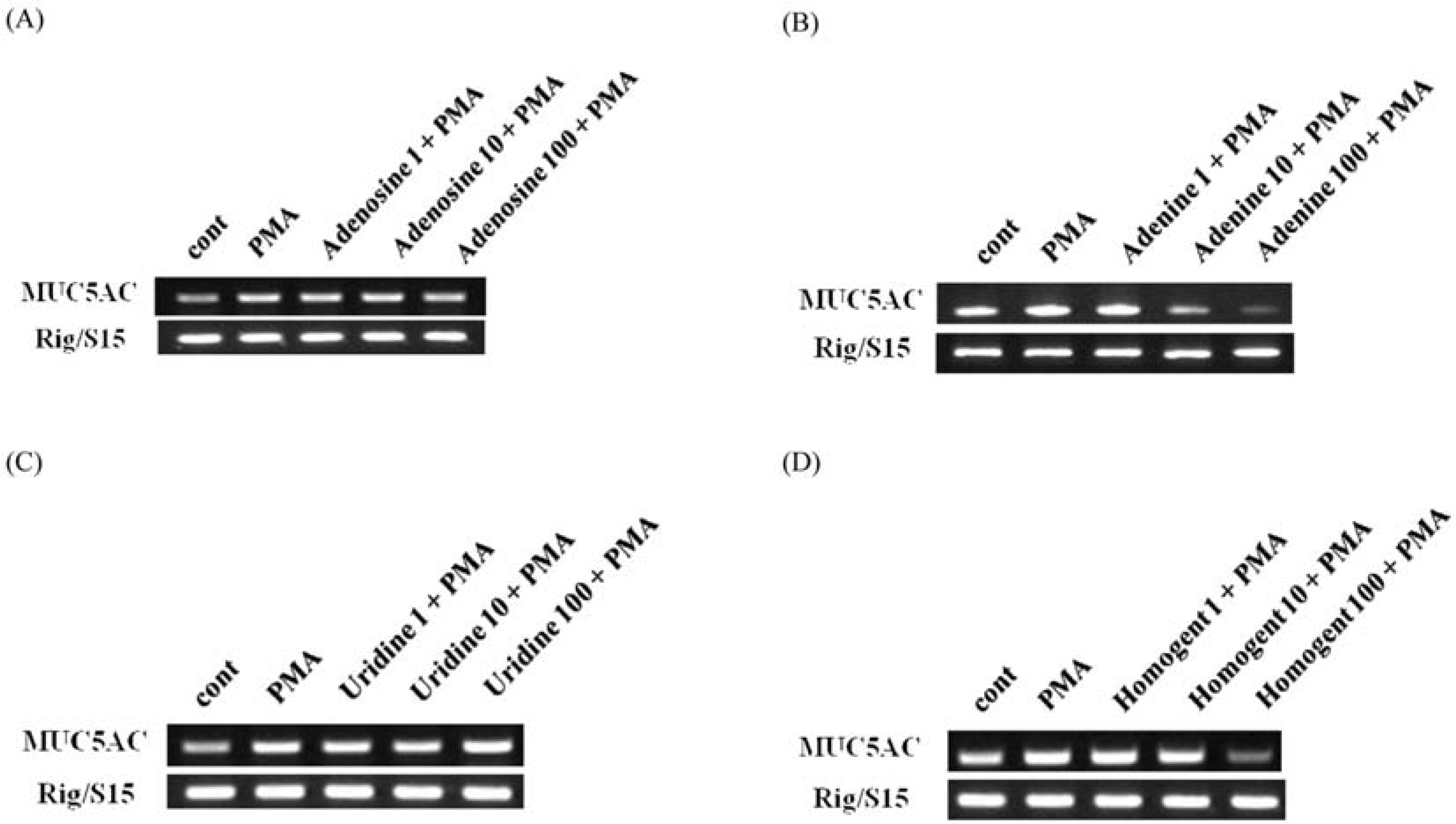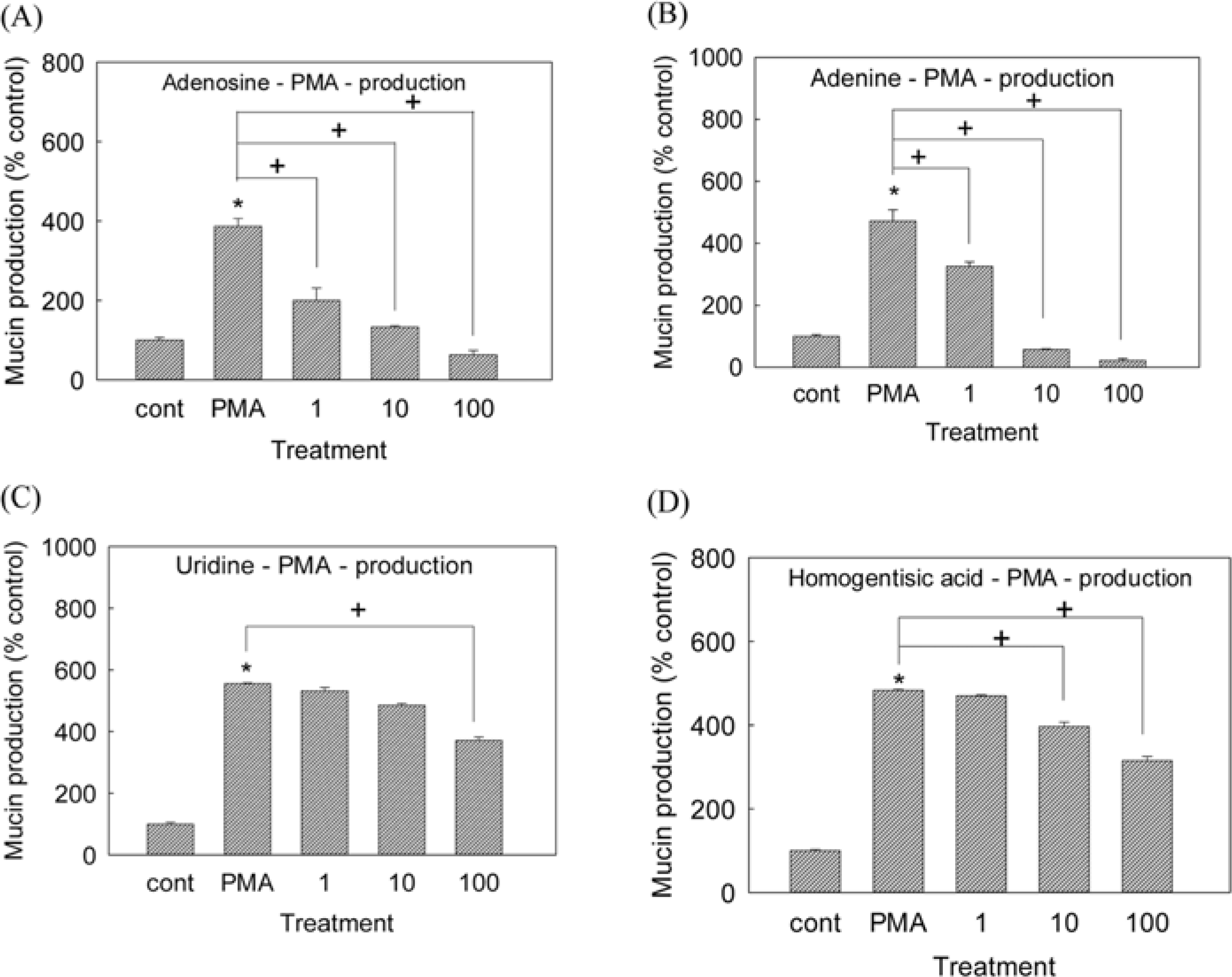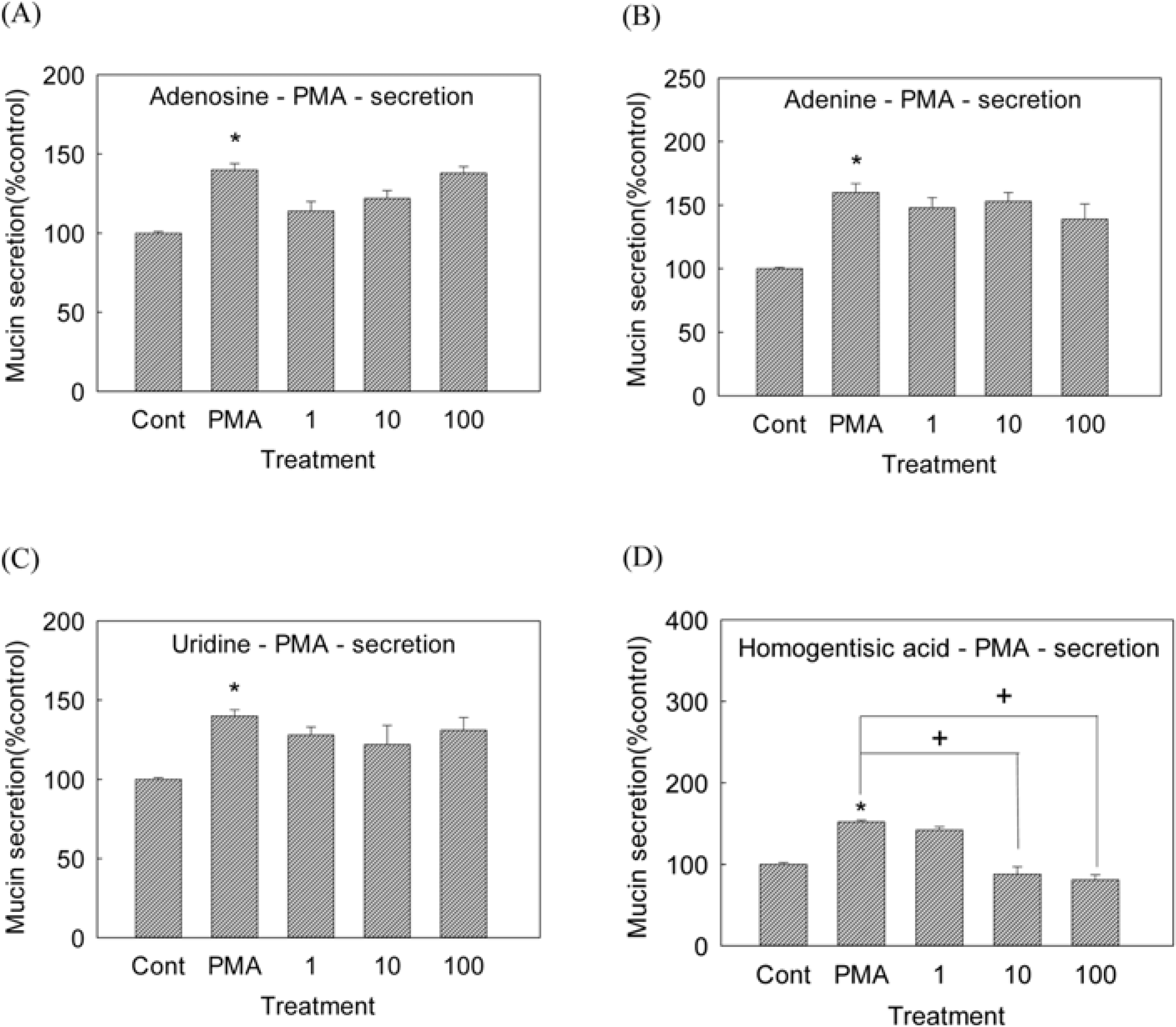Abstract
In this study, we investigated whether adenosine, adenine, uridine and homogentisic acid derived from Pinellia ternata affect the secretion, production and gene expression of MUC5AC mucin from airway epithelial cells. Confluent NCI-H292 cells were pretreated with adenosine, adenine, uridine or homogentisic acid for 30 min and then stimulated with PMA (phorbol 12-myristate 13-acetate) for 24 h. The MUC5AC mucin gene expression, mucin protein production and secretion were measured by RT-PCR and ELISA, respectively. The results were as follows: (1) Adenine and homogentisic acid decreased PMA-induced MUC5AC mucin gene expression, although adenosine and uridine did not affect the mucin gene expression; (2) Adenosine, adenine, uridine and homogentisic acid inhibited PMA-induced MUC5AC mucin production; (3) Homogentisic acid inhibited the secretion of MUC5AC mucin from NCI-H292 cells. These results suggest that, among the four compounds examined, homogentisic acid showed the regulatory effect on the steps of gene expression, production and secretion of mucin, by directly acting on airway epithelial cells.
Go to : 
References
(1). Lee C. J.., Park S. H.., Ko K. H.., Kim K. C.Inflamm. Res. 2002. 51:490–494.
(2). Voynow J. A.., Rubin B. K.Chest. 2009. 135:505–512.
(3). Heo H. J.., Kim C.., Lee H. J.., Kim Y. S.., Kang S. S.., Seo U. K.., Kim Y. H.., Park Y. C.., Seok J. H.., Lee C. J.Phytother. Res. 2007. 21:462–465.
(4). Heo H. J.., Lee S. Y.., Lee M. N.., Lee H. J.., Seok J. H.., Lee C. J.Phytother. Res. 2009. 23:1458–1461.
(5). Kim K. D.., Lee H. J.., Lim S. P.., Sikder A.., Lee S. Y.., Lee C. J.Phytother. Res. 2012. 26:1301–1307.
(6). Lee M. Y.., Shin I. S.., Jeon W. Y.., Lim H. S.., Kim J. H.., Ha H.Immunopharmacol. Immunotoxicol. 2013. 35:410–418.
(7). Ok I. S.., Kim S. H.., Kim B. K.., Lee J. C.., Lee Y. C.Mediators Inflamm. 2009. 2009:413270.
(8). Noone P. G.., Bennett W. D.., Regnis J. A.., Zeman K. L.., Carson J. L.., King M.., Boucher R. C.., Knowles M. R.Am. J. Respir. Crit. Care Med. 1999. 160:144–149.
(9). Okada S. F.., Zhang L.., Kreda S. M.., Abdullah L. H.., Davis C. W.., Pickles R. J.., Lazarowski E. R.., Boucher R. C.Am. J. Respir. Cell Mol. Biol. 2011. 45:253–260.
(10). Kim K. C.., Park H. R.., Shin C. Y.., Akiyama T.., Ko K. H.Eur. Respir. J. 1996. 9:542–548.
(11). Schmid A.., Clunes L. A.., Salathe M.., Verdugo P.., Dietl P.., Davis C. W.., Tarran R.Subcell. Biochem. 2011. 55:95–138.
(12). Rogers D. F.., Barnes P. J.Ann. Med. 2006. 38:116–125.
(13). Li J. D.., Dohrman A. F.., Gallup M.., Miyata S.., Gum J. R.., Kim Y. S.., Nadel J. A.., Prince A.., Basbaum C. B.Proc. Natl. Acad. Sci. USA. 1997. 94:967–972.
(14). Shao M. X.., Ueki I. F.., Nadel J. A.Proc. Natl. Acad. Sci. USA. 2003. 100:11618–11623.
(15). Takeyama K.., Dabbagh K.., Lee H. M.., Agustí C.., Lausier J. A.., Ueki I. F.., Grattan K. M.., Nadel J. A.Proc. Natl. Acad. Sci. USA. 1999. 96:3081–3086.
(16). Yalcin F. N.., Ersoz T.., Akbay P.., Calis I.Turk. J. Chem. 2003. 27:703–711.
(17). Park C. H.., Hur J. M.., Song K. S.., Park J. C.Kor. J. Pharmacogn. 2007. 38:263–269.
(18). Chen L.., Zhou Y. L.., Xing R. Y.., Zhu J.., Dong J. X.Nat. Pro. Res. Dev. 2010. 22:1001–1002.
(19). Hong D. H.., Petrovics G.., Anderson W. B.., Forstner J.., Forstner G.Am. J. Physiol. 1999. 277:G1041–G1047.
(20). Hewson C. A.., Edbrooke M. R.., Johnston S. L. J.Mol. Biol. 2004. 344:683–695.
(21). Park S. J.., Kang S. Y.., Kim N. S.., Kim H. M.Immunopharmacol. Immunotoxicol. 2002. 24:211–226.
Go to : 
 | Fig. 1.Chemical structure of uridine (1), adenine (2), adenosine (3) and homogentisic acid (4). |
 | Fig. 2.Effect of adenosine, adenine, uridine or homogentisic acid on PMA-induced MUC5AC mRNA expression from NCI-H292 cells. NCI-H292 cells were pretreated with varying concentrations of adenosine, adenine, uridine or homogentisic acid for 30 min and then stimulated with PMA (10 ng/mL) for 24 h. MUC5AC mRNA expression was measured by RT-PCR. Three independent experiments were performed and the representative data were shown. |
 | Fig. 3.Effect of adenosine, adenine, uridine or homogentisic acid on PMA-induced MUC5AC mucin production from NCI-H292 cells. NCI-H292 cells were pretreated with varying concentrations of adenosine, adenine, uridine or homogentisic acid for 30 min and then stimulated with PMA (10 ng/mL) for 24 h. Cell lysates were collected for measurement of MUC5AC mucin production by ELISA. Three independent experiments were performed and the representative data were shown. Each bar represents a mean ± S.E.M. of three culture wells in comparison with that of control set at 100%. ∗significantly different from control (p < 0.05). +significantly different from PMA alone (p < 0.05). (cont: control, concentration unit is µM.) |
 | Fig. 4.Effect of adenosine, adenine, uridine or homogentisic acid on PMA-induced MUC5AC mucin secretion from NCI-H292 cells. NCI-H292 cells were pretreated with varying concentrations of adenosine, uridine or homogentisic acid for 30 min and then stimulated with PMA (10 ng/mL) for 24 h. Spent media were collected for measurement of MUC5AC mucin secretion by ELISA. Three independent experiments were performed and the representative data were shown. Each bar represents a mean ± S.E.M. of three culture wells in comparison with that of control set at 100%. ∗significantly different from control (p < 0.05). +significantly different from PMA alone (p < 0.05). (cont: control, concentration unit is µM.) |




 PDF
PDF ePub
ePub Citation
Citation Print
Print


 XML Download
XML Download